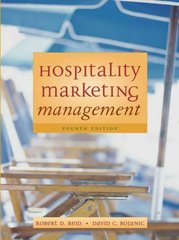Mike Clark recently became the manager of a full-service restaurant. The restaurant is in a Midwest resort
Question:
Mike Clark recently became the manager of a full-service restaurant.
The restaurant is in a Midwest resort town of 10,000 people. The town is located along the coastline of one of the Great Lakes and is approximately 10 miles from an industrial town of 150,000 people and 35 miles from a progressive city of almost 200,000 residents. The summers are mild and seldom hot, while the winters are often bitter and snowy. The restaurant is part of a small well-known upper Midwest chain. The resort town, although only about 2 miles from a substantial four-lane, limitedaccess road that connects coastal communities, is 10 miles from the nearest interstate highway.
The restaurant is upscale and attractive to summer vacationers. The restaurant has an English pub look and feel to it, with yards of ale and artifacts from England and Scotland. The food prices are considered to be moderately expensive for this midwestern resort town. There is no restaurant of comparable quality within a 20-mile radius. The restaurant dining area can accommodate 250 guests at one sitting and can comfortably seat another 40 to 50 people in the bar area for cocktails. The bar sales consist primarily of guests waiting to be seated or who drink after dinner. On Friday and Saturday nights the bar has a folk singer or musician to entertain. The restaurant is open seven days a week during the summer months, and Monday through Saturday after Labor Day. Lunch is served from 11 A.M. to 5 P.M. Monday through Saturday, with dinner from 5 to 11 P.M.
A typical lunch count in the summer is 100 to 120 meals, while a weekend dinner in the summer serves as many as 550 guests. During the offseason, Labor Day to Memorial Day, lunches shrink to 50 to 70 covers and dinner during the week ranges from 10 to 50 guests, while Friday and Saturday nights range from 80 to 150 guests depending on weather, holidays, and other local events. To accommodate the wide fluctuation in guests, the restaurant relies on college students in the summer. There are approximately 10 long-term employees and 3 managers who work year-round: a restaurant manager, a back-of-the-house manager, and a front-of-the-house manager.
Case Study Questions and Issues
1. How can Mike and his new public relations employee generate more local customer business in the off-season?
2. What can they do to entice residents of neighboring communities to drive 10 to 35 miles for an upscale dinner?
3. What type of advertising and promotions might increase local community traffic?
4. What other information is necessary to make advertising and promotion decisions?
Step by Step Answer:

Hospitality Marketing Management
ISBN: 9780471476542
4th Edition
Authors: Robert D Reid, David C Bojanic





